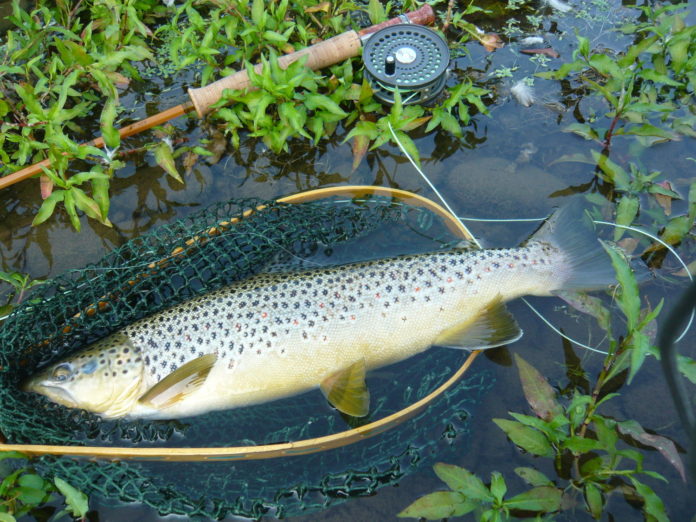By TONY BONAVIST
These days, with all the social media chatter and fast-paced lifestyles, it is hard to know how many anglers have what we used to call a “home water.” From what I’ve observed over the last 20 years or so, fly fishing is now driven by promotion, tackle companies, state and provincial PR firms and, to some extent, the guiding industry. Folks in this era don’t appear to evolve from fishermen and women to fly fishers. Instead, many who are new to the sport learn through fly fishing organizations, fly fishing schools and guided trips. In addition, this new wave of fly fishers depends on guidance from the internet about streamflow, water temperature and fly hatches to determine where and when to fish; it is no longer knowledge gained by fishing over a period of several years. And with airline travel available to just about any destination on the globe, there are no longer places too remote for anglers to reach, like the Amazon or Argentina, Chile, Russia and even Mongolia.
Not too long ago, it wasn’t like that—partly because most folks that had a desire to fish learned as kids, fishing a local pond with a can of worms. As they grew and became more knowledgeable about fishing, some were exposed to fly fishing and mentored by kind and helpful men. That’s how I started on this lifelong journey. In addition, many anglers didn’t have the opportunity to travel long distances to fish. As a result, most of us were lucky to be able to fish rivers and streams that were reasonably close to home. That meant we fished a certain water a great deal of the time. It was where we learned when the best times and where the best pools were to fish, where the fish held and, when we began to fly fish, when the hatches started.
When I was a young man in Westchester County, NY, I had the good fortune to be tutored on the finer points of fly fishing by several men who showed me how to tie flies and took me fishing. During that period, the Amawalk Outlet, a small tailwater that flowed between the Amawalk Reservoir and Muscoot Reservoir, is where I fished the most. As a result, I learned the intimacies of that little river—the Amawalk became my “home water.” Years later, while a student at the University of Montana, and because I did not have a car, the Bitterroot River near Missoula became my “home water.”
The first time I fished the East Branch of the Delaware River, just outside of Downsville, NY, was in 1959. That was shortly after the Pepacton Reservoir was completed and began releasing water downstream to comply with the 1954 Supreme Court decree that required NYC to help maintain a flow at Montague, NJ. My friends and our counselor, Ted Boeglin, camped at the old Del Valley Campground on Memorial Day weekend. There was pretty good fishing with the dry fly. We returned again in 1960 to camp and fish. After college, I returned to the Catskills. At the time, and because of the pitiful releases from the Pepacton Reservoir, the East Branch was a seasonal fishery. If Pepacton spilled in the spring, there was fishing until the spill stopped; that’s when we fished the East Branch. If the flow held, we had good fishing during the Hendrickson hatch. Once the spill stopped, the release was insufficient to support trout fishing, at least at that time. Nevertheless, we went back each spring with hope the reservoir would spill and there would be fishing.
Finally, in 1976, the Water Releases Legislation was passed, and the East Branch received enough water to support fishing throughout the entire trout season. Now, I fish the East Branch almost exclusively because, over a period of 60 years, we’ve evolved together. During those years, the river went from a spring stream dependent on a spill to a viable, season-long, superb tailwater supported by bottom release. During that same time frame, I’d like to believe I became a better fly fisher and, now, a fair writer of fishing tales.
Why a “home water”? For those of us, which I expect at this point in time are few, sticking with one really good river over a period of years has a great many benefits. Those who can commit to a river learn many of its little secrets: the best places to fish, best times to fish and when the hatches occur. In addition, staying with a special river over an entire season provides the dedicated angler excellent fly fishing opportunities. I guess this is another way of saying that the law of averages seems to always catch up.
But I believe there is more to it than that—the fishing. Some of us who spent a lot of time on a particular river spent it with friends and camped there. So trips to the river became social events with special people over a period of many years. I spent about 20 years with several good friends fishing the East Branch. Now every time I fish the river, their memories are intertwined with the river, and my thoughts of all the years we fished there are with them. The East Branch is a special, if sometimes difficult, river. It is my “home water.”
Credit: Source link






























